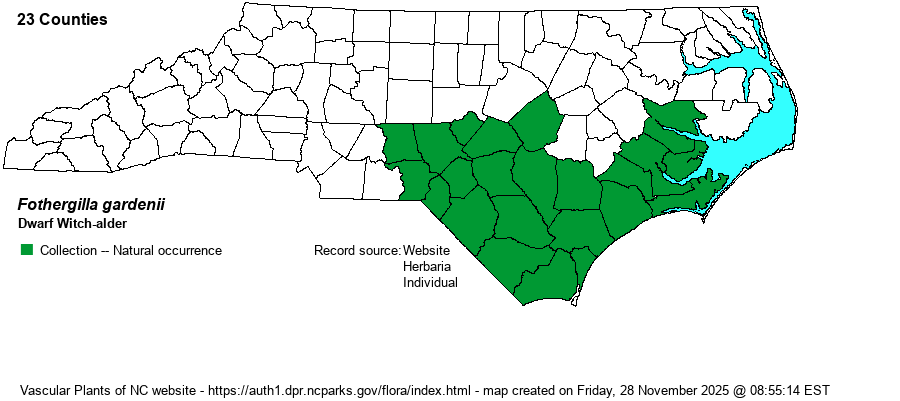| Author | L. | |
| Distribution | Strictly in the southern Coastal Plain, north to Johnston and Beaufort counties. The Montgomery County specimen came from near Naked Creek, 2.5 miles E of Norman.
This is a Southern species with a small range. It occurs from eastern NC south to southeastrn GA.
| |
| Abundance | Generally uncommon to infrequent, but it can be fairly common at least locally in the Sandhills region. Rare north of the “Longleaf Pine zone” in the central Coastal Plain. | |
| Habitat | This is one of the classic pocosin species, found in damp, acidic ground. It is most numerous in streamhead pocosins, but it also occurs at larger pocosins, particularly along the margins -– such as near rims of some Carolina bays. It may be found in savannas and flatwoods, as well. Though occasionally it may occur in sizable stands, it is usually found as scattered small groups mixed with other and often taller shrub species. | |
| Phenology | Blooms in April and May, usually as the leaves are just unfurling and definitely not in full leaf. Fruits in September and October. | |
| Identification | This is a fairly short deciduous shrub that grows only to about 2-3 feet tall. The alternate leaves are rather glaucous blue-green, being ovate to elliptic, but with the outer half of the leaves being quite coarsely toothed; they grow to about 3 inches long and about 2 inches wide. The coarsely serrated outer half of the leaves are distinct among pocosin shrub species (as Witch-Hazel [Hamamelis virginiana] seldom grows in acidic wetlands), and the glaucous color also makes the plants a bit conspicuous among most other shrubs with their bright green or dark green leaves. The inflorescence is very showy in spring, as the dozens of dense thimble-shaped clusters of small flowers, without petals but with long white stamens, gives the shrubs a glowing white look at that season. | |
| Taxonomic Comments | A few older references listed the species as F. gardeni (instead of gardenii). Very recently, a paper was published that split gardenii into 3 species (Haynes et al. 2020). The 2 new splits occur in SC, GA, AL, and FL. All NC material remains as gardenii.
| |
| Other Common Name(s) | Dwarf Fothergilla, Coastal Fothergilla, Coastal Witch-alder | |
| State Rank | S3S4 | |
| Global Rank | G3G4 | |
| State Status | | |
| US Status | | |
| USACE-agcp | FACW link |
| USACE-emp | FACW link |

